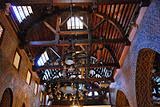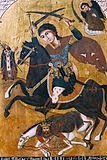Les Melkites d’Egypte, d’un siècle à l’autre :
Enracinement et
Rayonnement
Robert Solé, Journaliste et Écrivain
Paru dans : Le
Lien, Revue du Patriarcat Grec-Melkite-Catholique, Hors Série 2014.
Je suis né en Egypte, j’y ai vécu jusqu’à l’âge de 17 ans,
dans une famille grecque-catholique. Par mon père comme par ma mère,
j’appartiens à cette communauté qui, bien que très minoritaire, a joué un rôle
important sur les bords du Nil, dans tous les domaines : industriel,
commercial, intellectuel, social.
C’est au lendemain du rattachement de l’Eglise melkite à
Rome, dans les années 1730-1740, que l’on assiste aux premières arrivées de
grecs-catholiques en Egypte. Il s’agit généralement de négociants venus d’Alep,
de Damas, de
Beyrouth, de la montagne libanaise ou de Saïda : attirés par la
richesse de l’Egypte, désireux d’y trouver un havre de paix, loin des avanies
que leur inflige la hiérarchie grecque-orthodoxe, ils s’installent dans le nord
du pays, à Damiette ou à Rosette.
 |
| Cedres du Liban |
Et, là, ils s’imposent avec une rapidité surprenante : ils
développent le commerce avec les Européens, importent des draps de France,
exportent du riz, prennent le contrôle du commerce, puis celui des douanes qui,
jusqu’alors, était l’apanage des juifs. Ainsi, en 1774, le Grand Douanier
d’Egypte s’appelle Antoun Faraon. Seule la douane de Suez lui échappe. Sept ans
plus tard, le consul de France constate : « En quelques années, les Syriens se
sont emparés de tout le commerce qui se fait avec l’Inde et l’Arabie par
la mer Rouge, de celui de Syrie, d’une partie de celui de Smyrne. »
Parallèlement à ce succès commercial, les melkites essaient
de se constituer en unité administrative indépendante. Pour s’affranchir de la
tutelle du patriarche grec-orthodoxe, ils s’appuient sur la Mission des Pères
de Terre Sainte et sur les consuls de France. Mais ils essaieront ensuite,
pendant les deux dernières décennies du XVIIIe siècle, de s’affranchir du
contrôle des latins.
 |
| Banaparte en Egypte |
Quand Bonaparte débarque en Egypte en 1798, les melkites
comptent un chef en la personne de Michel Kahil, un gros négociant du Caire.
C’est lui qui est chargé de percevoir les impôts dus par les membres de sa
communauté, forte de quatre mille personnes. L’anarchie qui règne alors dans le
pays, gouverné par les mamelouks, fait voir avec bonheur aux catholiques
originaires de Syrie l’arrivée des troupes françaises.
Dès son arrivée au Caire, Bonaparte créée l’Institut
d’Egypte, qui réunit les plus importants « savants et artistes » qui
l’accompagnent. Cette institution ne compte ni coptes ni musulmans. Son seul
membre oriental est un moine grec-catholique, Antoine Zakhour, connu sous le
nom de dom Raphaël. Né au Caire, ayant complété sa formation à Rome, il possède
parfaitement l’arabe, le copte, le français et l’italien. Dans les années
qui suivront le départ des Français d’Egypte, il enseignera à l’École des
langues orientales de Paris, donnera des cours d’arabe à Jean-François
Champollion et l’orientera vers l’étude du copte, qui se révélera décisive pour
le déchiffrement des hiéroglyphes.
Dom Raphaël reviendra
en Egypte sous le règne de Mohammed Ali pour participer à la mise en place de
la première imprimerie égyptienne, à Boulaq.
 |
| Presse des années 1880 |
Souvent polyglottes, ouverts sur le monde extérieur, les
melkites sont pour les Français de précieux auxiliaires. Eux-mêmes se sentent
mieux protégés par ce nouvel occupant. Certains prendront les armes aux côtés
des soldats de Bonaparte pour combattre les mamelouks, les Ottomans ou les
Anglais. Les plus compromis d’entre eux partiront en 1801 avec les troupes
françaises, défaites, pour s’installer à Marseille. Ils y construiront vingt
ans plus tard Saint-Nicolas de Myre, première église catholique orientale de
France. Mais la plupart des melkites resteront en Égypte, où les attendra un
bel avenir sous le règne de Mohammed Ali.
Une nouvelle vague d’émigration de Syriens (appelés Chawam
en Egypte) survient après les massacres de 1860 à Damas et dans la montagne
libanaise. La vallée du Nil, alors prospère, fait figure de « Far East ». On
s’y bouscule, de toutes les rives de la Méditerranée.
A leur tour, quand ils occupent l’Egypte à partir de 1882,
les Anglais s’appuient sur les Chawam. La nouvelle administration a
besoin de ces intermédiaires polyglottes, capables de s’adapter facilement,
alors que les coptes sont plutôt confinés dans l’administration financière.
Les Syriens en général, et les melkites en particulier,
savent jouer de la rivalité franco-anglaise. Ils sont comme des poissons dans
l’eau dans cette Egypte cosmopolite, où cohabitent, de manière plutôt
harmonieuse, des personnes de nationalité ou d’origine nationale différente,
appartenant à diverses religions. Ils forment une bonne partie des effectifs
des écoles catholiques françaises. Dans les années 20, Henri Gaillard, le
représentant de la France au Caire, câble à son gouvernement : « C’est
notre meilleure clientèle en Egypte. »
L’habileté et le sens du commerce donnent naissance à
quelques grandes fortunes. C’est le cas de Habib Sakkakini, membre d’une
modeste famille grecque-catholique de Damas, émigrée en Egypte, qui se
distingue dès l’âge de vingt ans : il réussit à neutraliser les rats qui
mangeaient la nourriture des ouvriers du canal de Suez et détérioraient le
matériel… en faisant acheminer sur les chantiers des centaines de chats. Il
sera nommé par la suite responsable de l’assèchement des marais du Caire et
promu pacha.
Pour sa part,
Samaan Sedanoui fonde en 1878, dans le
quartier du Mouski, au Caire, une
mercerie qui deviendra, avec les années, l’un des grands magasins d’Egypte,
avec des établissements dans les principales villes du pays. On y trouvera des
tissus, des vêtements, des meubles, de l’électroménager… Encore un pacha
grec-catholique.
 |
| Maison Sednaoui |
Des Chawam jouent un rôle essentiel dans la renaissance intellectuelle, la Nahda, à la fin du 19è siècle. Entre 1873 et 1907, ils fondent 97 journaux ou revues, soit 15% des nouveaux titres parus en Egypte. Or, en 1907, ils ne sont que 34 000, sur une population de 11 millions d’habitants. Ce sont des melkites, les frères Bichara et Sélim Takla, qui créent le quotidien Al Ahram en 1876.
 |
| Vieux Ahram |
 |
| Michel Chalhoub alias Omar Sharif |
C'est à la suite d'une rencontre avec une grande bourgeoise melkite, Mary Kahil, avec laquelle il fonde en 1934 un tiers-ordre, la Badaliyya, que l’islamologue français Louis Massignon décide de rejoindre le clergé grec-catholique.
Il est secrètement ordonné prêtre le 28 janvier 1950, à
l'Eglise Sainte-Marie-de-la-Paix, au Caire, et n’aura le droit le célébrer la
messe qu'en privé.
Même s’ils comptent plusieurs pachas et ministres sous la
monarchie, les melkites s’engagent très peu dans la vie politique égyptienne.
Ils brillent, en revanche, dans l’industrie et le commerce. Au début des années
1950, ils occupent, dans la direction des sociétés cotées en bourse, une place
vingt fois supérieure à leur nombre relatif dans la population égyptienne.
L’une de leurs réalisations les plus originales est due à un
jésuite, Henry Ayrout. Fils d’un riche entrepreneur qui a été associé à la
construction de la ville d’Héliopolis, ce religieux s’est passionné pour le
sort des paysans, auquel il a consacré sa thèse de doctorat, avant de fonder,
en 1940, l’Association des Ecoles chrétiennes de Haute-Egypte. Toujours très
active, celle-ci dispense aujourd’hui un enseignement gratuit à des dizaines de
milliers d’enfants de toutes confessions et favorise des actions de
développement dans de nombreux villages.
 |
| Borg AL-Kahira |
Le coup d’Etat militaire de 1952 et surtout la crise de Suez
en 1956 ont porté un coup fatal à l’Egypte cosmopolite. Cela n’a pas empêché
les melkites de continuer à se distinguer dans la vie économique et sociale.
C’est à l’un d’eux par exemple, l’architecte Naoum Chebib, que l’on doit la
célèbre Tour du Caire.
Le régime de Nasser
n’a cessé de se durcir, à mesure qu’il accumulait les échecs (guerre du Yémen,
union avec la Syrie…).
Des familles grecques catholiques ont été particulièrement
visées par les nationalisations survenues au début des années 1960. Dans un
climat devenu plus lourd, elles n’ont pas été les seules à prendre le chemin de
l’exil : une grande partie de la communauté s’est réfugiée au Liban, en Europe,
en Amérique ou même en Australie.
Réduite aujourd’hui à quelque 5 000 membres, elle reste
cependant très présente en Egypte, dans le commerce, l’industrie, la médecine,
ou à la tête d’écoles catholiques. L’Eglise melkite compte sept paroisses au
Caire, quatre à Alexandrie, une à Tanta et une autre à Mansoura. Parmi les
établissements scolaires qu’elle administre, on peut citer deux collèges
patriarcaux, ainsi que l’école des religieuses de
Notre-Dame-du-Perpétuel-Secours. Les melkites tiennent le bureau de presse des
Eglises catholiques d’Egypte, dont le porte-paroles est le Père Rafic Greiche,
le curé de la paroisse Saint-Cyrille, à Héliopolis. Ce prêtre très actif
dirige l’hebdomadaire Le Messager, édité en trois langues (arabe,
anglais, français) et publie régulièrement des articles remarqués dans la
presse égyptienne, tout en organisant régulièrement des colloques avec des
intellectuels.
Une intégration réussie dans un pays suppose deux conditions
: que l’on veuille s’intégrer et que l’on veuille vous intégrer. Aucune de ces
deux conditions n’était totalement remplie jusqu’à une date récente. Les Chawam
– encore désignés ainsi malgré tout ce qu’ils avaient réalisé en Egypte –
n’étaient pas considérés comme des nationaux à part entière, et eux-mêmes
avaient sans doute besoin, pour exister, de ne pas se fondre entièrement dans
le décor. Ce n’est plus tout à fait vrai.
Nombre de grecs-catholiques ont activement participé, aux
côtés de leurs concitoyens musulmans ou coptes, aux manifestations qui ont
conduit au renversement du président islamiste Mohamed Morsi en juin 2013.
L’avenir des melkites d’Egypte est lié à la manière dont le pays évoluera.
Quant au passé de la communauté, il se « lit » en parcourant
les allées du cimetière grec-catholique du Vieux-Caire. Ce lieu paisible me
touche particulièrement : c’est là que sont enterrés beaucoup de mes ancêtres
et la plupart des personnages de mes romans.
Robert Solé





















